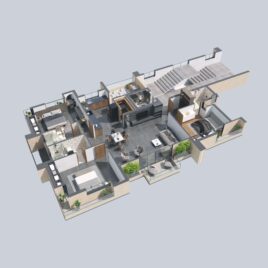The integration of Augmented Reality (AR) into the field of interior design is revolutionizing how spaces are conceptualized, designed, and experienced. By blending digital elements with the physical world, AR offers innovative solutions that bridge imagination and reality. This article explores the transformative role of AR in interior design and highlights its implications for the future.
The Role of AR in Interior Design
What is Augmented Reality?
Augmented Reality (AR) overlays digital visuals, sounds, and other sensory inputs onto the real world through devices like smartphones, tablets, and AR glasses. Unlike virtual reality, AR enhances reality rather than replacing it, making it a perfect fit for the field of interior design.
AR in Space Visualization
One of the primary challenges in interior design is visualizing how furniture, décor, and colors will look and fit within a space. AR eliminates this guesswork by allowing users to see how elements will appear in real-time. With AR, clients can preview design concepts at scale and adjust elements such as:
- Furniture placement
- Color schemes
- Lighting conditions
Key Advantages of AR in Interior Design
Enhanced Client Experience
AR allows clients to actively engage in the design process. By visualizing changes before committing to them, they gain confidence in their choices. Tools like IKEA Place empower customers to “try before they buy” by placing virtual furniture into their spaces through AR-enabled apps.
Saving Time and Costs
Traditional design processes often require physical prototypes, sample boards, or trial installations. AR bypasses these costly steps, streamlining project timelines. Designers can quickly test concepts without physical resources, reducing material waste and expenses.
Trendy Applications of AR in Interior Design
Virtual Showrooms
Retailers and designers increasingly use AR for virtual showrooms, allowing customers to explore products from the comfort of their homes. These showrooms use AR to showcase 3D models of furniture, fixtures, and décor items in lifelike detail.
Interactive Design Apps
AR-enabled apps have democratized interior design, making it accessible to anyone. Platforms like Houzz and Planner 5D let users experiment with layouts, designs, and color schemes by integrating AR tools into their interfaces.
The Role of AR in Personalized Design
Tailored Solutions for Unique Needs
Every client has unique tastes and preferences. AR allows designers to create tailored solutions by quickly iterating on ideas and receiving immediate feedback. Clients can see their personalized designs come to life, ensuring satisfaction with the end product.
Collaborative Design Process
AR fosters collaboration between designers and clients by making it easy to share and discuss ideas. Clients can actively participate in the design process, resulting in spaces that genuinely reflect their style and needs.
Challenges and Limitations
Technological Barriers
Despite its advantages, AR relies on advanced hardware and software. The accessibility of AR technology can be a hurdle, particularly for small businesses or clients without the necessary devices.
Learning Curve for Designers
Interior designers need to familiarize themselves with AR tools and software. This learning curve can slow down adoption, but as AR technology becomes more user-friendly, this challenge is likely to diminish.
The Future of AR in Interior Design
Integration with Artificial Intelligence
The future of AR in interior design lies in its integration with Artificial Intelligence (AI). By combining AI algorithms with AR tools, designers can generate personalized recommendations and automate tedious design tasks, such as calculating dimensions or matching colors.
Sustainable Design Practices
AR also supports sustainability by reducing waste and promoting resource-efficient design. Virtual prototypes minimize the need for physical mockups, contributing to eco-friendly practices.
Conclusion
Augmented Reality is more than just a tool; it is reshaping the very fabric of interior design. From enabling precise visualizations to fostering client collaboration and promoting sustainable practices, AR is a game-changer. As technology evolves, AR will undoubtedly become an indispensable part of the design process, driving creativity, efficiency, and client satisfaction.
Embracing AR today means shaping the spaces of tomorrow with confidence and innovation.





